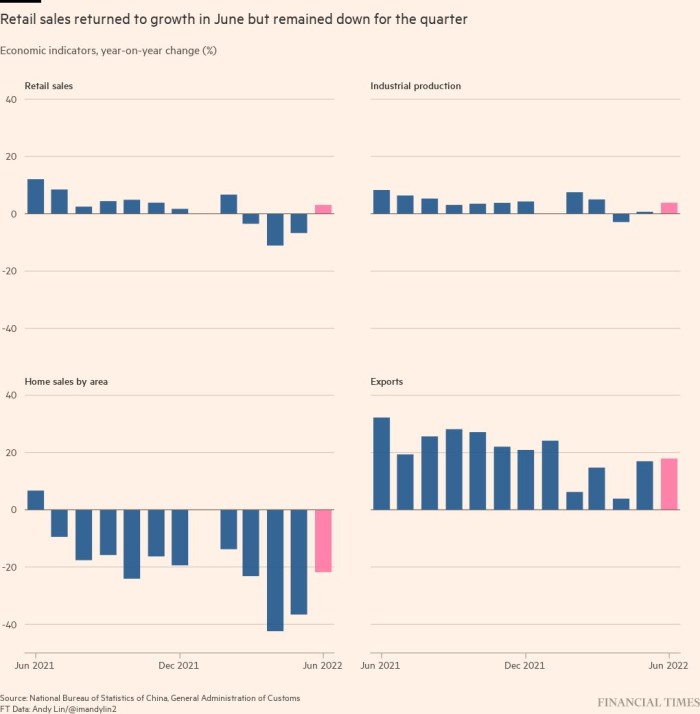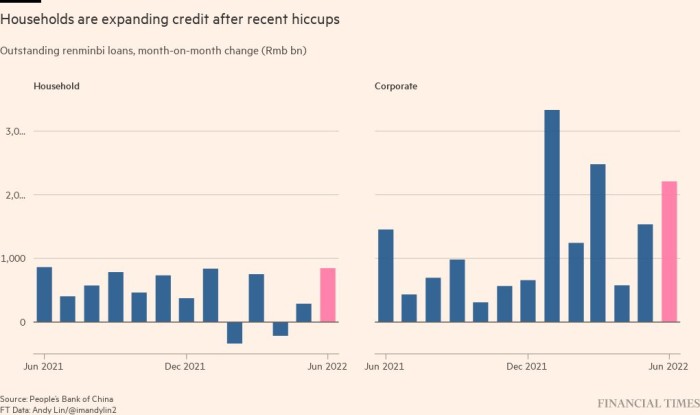China’s economy narrowly escaped a contraction in the second quarter as the fallout from President Xi Jinping’s zero-Covid policy stoked expectations that Beijing would inject hundreds of billions of dollars of stimulus to shore up growth.
The world’s second-biggest economy expanded 0.4 per cent year on year in the three months to the end of June, below the 1.2 per cent forecast by economists, and down from the 4.8 per cent recorded in the first quarter.
The slowdown reflected the hit from a two-month lockdown in Shanghai, which took full effect in April, and illustrated the threat to global growth from Xi’s attempt to eradicate Covid-19 in the world’s main manufacturing hub.
The National Bureau of Statistics figures were released at a tense juncture for Xi’s economic planners. Beijing’s battle to eradicate coronavirus outbreaks has relied on months of snap lockdowns and heavy-handed restrictions on mobility, dragging on the pace of China’s economic recovery.
The 0.4 per cent result marked China’s second-worst quarterly growth figure in 30 years, following a contraction at the start of the pandemic. With first-half growth at 2.5 per cent, Beijing is expected to miss its target of about 5.5 per cent annual growth for 2022, itself a three-decade low.
“These data highlight the unfavourable domestic and external circumstances that, in tandem with the government’s zero-Covid strategy, are squeezing economic activity and emphasise the dire need for short-term policy measures to revive growth,” said Eswar Prasad, economics professor at Cornell University and former head of the IMF’s China division.
He added that while investment growth had held up “better than expected”, it entailed “a slew of medium-term fiscal and financial risks”.
Adding further pressure on Xi’s administration, youth unemployment rose to a record of 19.3 per cent.
Thirty-one Chinese cities are under full or partial lockdowns, affecting 247.5mn people in regions accounting for about 17.5 per cent of the country’s economic activity, according to an analysis released this week by Japanese investment bank Nomura.
Xi’s administration has consistently said it would prioritise protecting the country from coronavirus outbreaks over the economy. It has blamed the country’s slowdown on the pandemic, the risks of stagflation and monetary tightening globally.
Fu Linghui, a spokesperson for the NBS, conceded reaching Beijing’s 5.5 per cent growth target this year would now be “challenging”.
“Generally speaking, with a series of policies to solidly stabilise the economy achieving notable results, the national economy has overcome the adverse impact of unexpected factors, demonstrating the momentum of a stable recovery,” Fu told reporters on Friday.
On a quarter-on-quarter basis, China’s gross domestic product fell 2.6 per cent, compared with a revised 1.4 per cent growth in the first three months of the year and below expectations of a 1.5 per cent contraction, according to a Reuters poll.
Retail sales, a critical gauge of sentiment in the world’s biggest consumer market, were down 4.6 per cent in the second quarter after a double-digit fall in April. Consumer spending has lagged behind the wider recovery since the start of the pandemic, in part because of travel restrictions.
Industrial production was up 3.9 per cent in June compared with the same period a year earlier. Factory output was up 0.7 per cent for the second quarter.
Julian Evans-Pritchard, a senior China economist with Capital Economics, said the three-month performance “was even weaker than meets the eye” despite improvements in June.
“The statistics bureau claims that output in the second quarter was slightly higher than a year ago,” he said. “That’s implausible even accounting for the strong rebound shown on the monthly data for June . . . This isn’t the first time that the official GDP figures have seemingly understated the extent of an economic downturn.”
Fixed asset investment, China’s main measure of capital spending, grew 5.6 per cent last month. Infrastructure investment was 7.1 per cent higher as Beijing increased its stimulus efforts, while real estate investment dropped 5.4 per cent.
China’s deeper economic slowdown may prompt looser monetary policy and fiscal stimulus, said analysts, in contrast to developed economies that are raising interest rates to tackle high inflation.
But a new phase of credit-fuelled investment risks undercutting attempts to deal with high leverage and bad debts in the property sector, which have raised worries over financial stability. The People’s Bank of China has been reluctant to cut interest rates for fear of capital outflows.
Despite criticism that the central government is reverting to debt-fuelled and wasteful spending — much of it targeted at large-scale infrastructure, and funded through local governments — Beijing is increasingly desperate to stem the economic slowdown and rising unemployment.
The Financial Times reported this week that local governments across China would be allowed to issue an additional Rmb1.5tn ($223bn) worth of bonds this year to boost flagging growth. The spending would be brought forward from next year’s quota.
Prasad, however, said “the room for manoeuvre” for monetary policy easing by the People’s Bank of China was narrowing because of rising US interest rates. He also noted risks posed by a “currency-depreciation capital outflow spiral that could be triggered by any broad and aggressive easing of monetary policy”.
Additional reporting by Tom Mitchell in Singapore and Jennifer Creery and Andy Lin in Hong Kong




